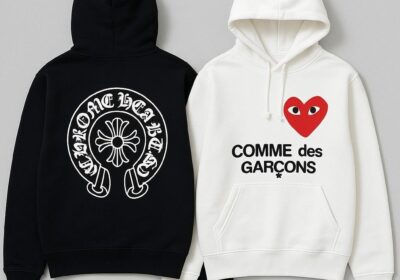In the constantly evolving world of fashion, few brands have wielded influence as subtly and profoundly as Comme des Garçons. Founded in 1969 in Tokyo, the brand developed a distinctive identity that defied conventional aesthetics, merging avant-garde sensibilities with the organic, raw authenticity of streetwear. Its influence transcends transient trends; it has fundamentally altered how youth culture and high fashion shopcommedesgarconn.com intersect, creating a space where experimental design meets everyday wear. The label is more than clothing—it is an articulation of attitude, a philosophy of rebellion and intellectual curiosity that resonates across generations, redefining cultural expectations and stylistic boundaries.
Origins of Disruption: Rei Kawakubo’s Vision
Rei Kawakubo, the creative force behind Comme des Garçons, approached fashion as conceptual art rather than a commercial enterprise. Early collections were characterized by asymmetrical cuts, oversized silhouettes, and an intentional disregard for conventional beauty standards, reflecting an anti-fashion ethos that challenged 1970s European norms. Kawakubo’s designs were philosophical experiments in form, texture, and proportion, turning garments into statements of conceptual rigor. This radical approach resonated with a generation seeking authenticity and intellectual engagement in their clothing choices. Her vision laid the groundwork for street style to embrace irregularity, rebellion, and self-expression, transforming clothing from simple utility into a medium of cultural dialogue and personal storytelling.
The Deconstruction Aesthetic and Its Street Resonance
Comme des Garçons’ deconstructionist approach became a hallmark of its identity, with garments that defy symmetry, feature raw hems, and play with volume and proportion in unexpected ways. These designs translated naturally into streetwear contexts, where individuality and nonconformity are highly valued. Urban communities, from skateboarders to fashion enthusiasts, adopted these garments as tools for personal expression, using irregular silhouettes to challenge societal norms and communicate subcultural literacy. The brand’s approach demonstrated that clothing could be more than functional—it could provoke thought, inspire creativity, and establish a sense of belonging. Its aesthetic fostered a visual language that became central to contemporary street culture.
Collaborations That Bridged Couture and the Streets
Strategic collaborations elevated Comme des Garçons’ reach, bridging the worlds of high fashion and streetwear. Partnerships with Nike produced footwear that balanced avant-garde design with practical wearability, while collaborations with Supreme injected conceptual design into youth-driven hype cycles. These projects were not merely marketing exercises; they served as cultural conduits, allowing diverse audiences to engage with the brand’s aesthetic philosophy. Streetwear enthusiasts gained access to sophisticated design thinking, while high-fashion consumers embraced street energy and authenticity. Such collaborations created a dynamic exchange, merging exclusivity with accessibility and inspiring a generation to view fashion as both art and lifestyle, catalyzing the global street style revolution.
Color, Texture, and Iconography: Redefining Urban Expression
Comme des Garçons’ visual language extends far beyond silhouette, embracing bold experiments with color, texture, and iconography. The brand’s use of stark monochromes, layered fabrics, and unconventional textiles challenges traditional fashion norms, encouraging wearers to think critically about form and sensation. Iconic motifs, including the heart emblem and abstract patches, serve as cultural signifiers, allowing individuals to communicate identity, affiliation, and taste without words. In urban environments, these visual cues act as markers of sophistication and cultural literacy. By merging aesthetic complexity with street sensibilities, Comme des Garçons empowers wearers to create personalized narratives, transforming everyday clothing into a rich medium of expression and social interaction.
Subcultural Adoption: From Underground to Mainstream
Comme des Garçons’ integration into subcultures like skateboarding, hip-hop, and alternative youth movements catalyzed its transition from underground icon to mainstream phenomenon. Early adopters, through word-of-mouth, grassroots exposure, and digital virality, amplified the brand’s desirability and cultural significance. By becoming embedded within these communities, the label gained legitimacy and credibility, signaling taste, rebellion, and sophistication simultaneously. This symbiosis between subcultural adoption and mainstream visibility created a feedback loop, inspiring future designs while cementing the brand’s status as an arbiter of street style. Its influence reshaped how youth and urban culture perceive fashion, establishing Comme des Garçons as a blueprint for authentic style evolution.
Retail and Presentation: The New Rules of Street Engagement
Beyond its design philosophy, Comme des Garçons transformed the way fashion is presented and consumed. Flagship stores became immersive environments, blending retail with gallery-like exhibition spaces that engage visitors intellectually and emotionally. Runway shows, often theatrical and experimental, merge fashion, performance, and art, challenging conventional notions of presentation. This innovative approach turns consumer engagement into an experience, inviting audiences to participate rather than passively observe. By redefining the rules of retail and presentation, the brand extends its conceptual ethos into everyday interaction, reinforcing its influence on street style while encouraging consumers to approach fashion as a participatory and intellectually stimulating activity rather than mere consumption.
Legacy and Enduring Influence
The legacy of Comme des Garçons in street style is enduring and transformative. Its aesthetics, from deconstructionist silhouettes to conceptual motifs, continue to inspire emerging designers and shape contemporary streetwear. By merging intellectual rigor with urban sensibility, the brand has blurred the lines between high fashion and everyday wear, challenging designers and consumers alike to reconsider clothing as a medium of expression. Its influence is not limited to garments but encompasses philosophy, presentation, and cultural engagement. Comme des Garçons has created a lasting template for street style, one where creativity, rebellion, and identity converge seamlessly, proving that fashion can be both disruptive and timeless.







Leave feedback about this